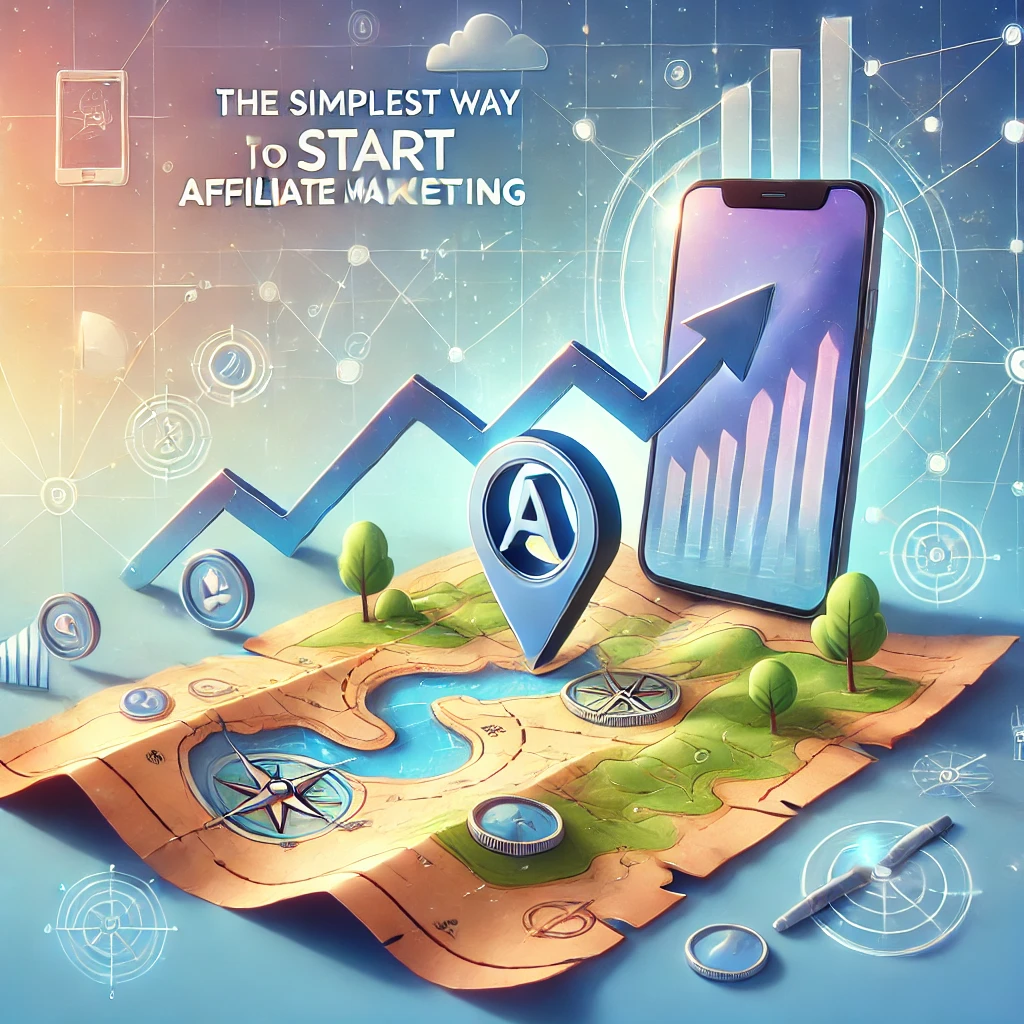Affiliate marketing isn’t just a digital revenue model—it’s a journey of creativity, perseverance, and smart decision-making. In this post, we’ll guide you step-by-step through the essentials of starting your affiliate marketing adventure, from understanding the basics to optimizing your efforts for long-term success.
Introduction
Imagine walking into your favorite coffee shop and discovering a hidden door that leads to a world where every small decision could earn you extra cash. That’s exactly how I felt when I first stumbled upon affiliate marketing. As a young professional juggling a 9-to-5 job with the desire for extra income, I was searching for a side hustle that wouldn’t demand a complete lifestyle overhaul. Affiliate marketing promised just that—a flexible, low-cost way to generate income while you pursue your passions. It’s like having a treasure map in your pocket that leads to hidden income streams, and today, I’m excited to share that map with you.
For more insights on starting your online business, [insert internal link: “read more on our blog page”].
Key Point 1: What is Affiliate Marketing? (A Beginner’s Overview)
Picture this: you recommend your favorite restaurant to a friend, and as a thank you, you get a discount or a small reward every time they visit. Now, imagine doing that online—except instead of a discount, you earn a commission every time someone buys a product through your unique link. That’s affiliate marketing in its simplest form.
At its core, affiliate marketing is a partnership. You, as the affiliate, promote a product or service, and when someone makes a purchase through your link, you earn a commission. Think of it as planting a seed in a well-tended garden: with a little nurturing, that seed can grow into a fruitful income stream. The process is straightforward:
- How It Works:
A company creates an affiliate program, provides you with a unique link, and tracks every sale made through that link. It’s a simple equation: your recommendation plus the customer’s trust equals commission. - Why Companies Use It:
Companies love this model because it’s cost-effective—they only pay for actual sales. It’s a win-win: you help them reach new customers, and they reward you for your influence. - The Benefits:
For you, the benefits include minimal startup costs, the potential for passive income, and the freedom to work on your own terms. It’s an ideal way to dip your toes into the world of online business without needing a massive upfront investment.
I still remember the first time I joined an affiliate program. Despite having barely a handful of followers on my blog, I took the plunge. As I began to share honest recommendations and learned the nuances of digital marketing, even those initial, modest commissions felt like personal victories—proof that even the smallest efforts can pay off in the big picture.
Key Point 2: Choosing the Right Niche (Set Yourself Up for Success)
Choosing the right niche is like finding your perfect spot at a vibrant street market—one where your passion, expertise, and the crowd’s appetite all meet. I remember the countless evenings I spent scrolling through different topics, feeling overwhelmed by the endless possibilities. It felt like being in a candy store with every flavor imaginable, yet not knowing which one would truly satisfy my hunger for success.
What Is a Niche and Why It Matters?
A niche is your unique corner in the vast online world—a specialized area where you can build your authority and connect deeply with an audience. It’s not just about picking a topic; it’s about finding that sweet spot where your interests and market demand intersect. Think of it as planting your flag in a territory where you can thrive without getting lost in a sea of competition.
How to Choose a Niche: Passion, Profit, and Demand
- Passion: Start with what excites you. When you’re passionate about a subject, creating content feels less like work and more like sharing a part of yourself.
- Profit: Consider whether the niche has a viable monetization strategy. Are there affiliate programs that offer attractive commissions?
- Demand: Use tools like Google Trends, Reddit, and social media to gauge what people are talking about. This research acts like a compass, helping you navigate towards the areas with the strongest market winds.
I experimented with niches ranging from tech gadgets to personal finance before finding the perfect blend of lifestyle and tech trends. That moment was like stepping into a sunlit clearing after a long forest hike—suddenly, the path ahead was clear and promising.
For additional tips on niche selection, [insert internal link: “click here to read more on our niche strategies”].
Key Point 3: Finding & Joining Affiliate Programs (Your Money-Making Partnerships)
Embarking on your affiliate journey is a bit like venturing into a bustling marketplace filled with stalls offering treasures. Each stall represents an affiliate program, and your task is to find the ones that align perfectly with your niche and goals.
The Basics of Affiliate Programs
An affiliate program is a partnership where companies provide you with unique tracking links. Every time someone makes a purchase using your link, you earn a commission—a slice of the sale. Imagine being a guide who leads customers to hidden gems in the marketplace and receives a token of appreciation for every successful referral.
Types of Affiliate Programs
- High-Ticket vs. Low-Ticket Programs:
Some programs offer high commissions on expensive products, while others pay smaller amounts on products that sell in high volumes. It’s like choosing between selling luxury watches or popular fashion accessories—each has its own rhythm and rewards. - Recurring vs. One-Time Commissions:
Certain programs offer recurring commissions, such as those based on monthly subscriptions, providing you with a steady income stream over time.
Where to Find Affiliate Programs
There is a treasure trove of platforms waiting to be explored:
- Amazon Associates: A well-known starting point, offering a vast range of products.
- ShareASale, Impact, and ClickBank: These platforms host numerous merchants across various niches, giving you the flexibility to pick what resonates with your audience.
Understanding Commission Structures
Understanding how each program pays out is crucial. Some might offer a flat fee per sale, while others give you a percentage of the sale amount. Picture it like choosing between a quick snack and a hearty meal—each option can satisfy your hunger differently.
I still recall the excitement mixed with a bit of nervousness when I joined my first affiliate program related to tech gadgets—a niche I was passionate about. Navigating the sign-up process felt like unlocking a door to an exclusive club, where the simple rule was to share genuine recommendations and reap the rewards.
Explore more detailed guides on joining affiliate programs by : “visiting our affiliate programs resource page“.
Key Point 4: Creating Content That Sells (The Art of Persuasion Without Selling)
Creating content that sells is the heartbeat of affiliate marketing—it’s where creativity meets strategy. Imagine preparing a gourmet meal where every ingredient, from the freshest produce to a pinch of spice, comes together to create a dish that delights your senses. Similarly, your content must blend information, personality, and persuasion to engage your audience without coming across as pushy.
The Essence of Persuasive Content
Content that sells isn’t about hard-selling a product. Instead, it’s about sharing a story that resonates. In the early days of my affiliate journey, my blog posts were straightforward and factual. They provided all the necessary details but lacked a spark. Once I began weaving in personal stories, vivid descriptions, and relatable experiences, everything changed. Readers began to see the genuine value behind my recommendations, and my engagement soared.
Strategies to Craft Compelling Content
- Tell a Story:
Use personal anecdotes to explain how a product made a difference in your life. For instance, recount the time a particular tech gadget solved a major problem at work, turning frustration into a moment of triumph. - Use Vivid Descriptions:
Compare the benefits of a product to everyday experiences. For example, describe a productivity app as “the digital equivalent of having a personal assistant who anticipates your every need.” - Build Trust with Transparency:
Honesty is your best ally. Share both the pros and cons of a product, much like a friend offering advice over coffee. This builds credibility and fosters trust with your audience.
Enhancing Your Content’s Visual Appeal
- Engaging Headlines and Subheadings:
Think of these as signposts on a trail, guiding your reader through your narrative. - Multimedia Elements:
Integrate short video snippets or high-quality images to illustrate the product in action. Visuals evoke emotions and can help clarify complex ideas.
By focusing on the art of storytelling, you transform ordinary product recommendations into memorable experiences—turning your content from a sales pitch into a shared journey toward better solutions.
For more creative content ideas, “explore our content creation guides“.
Key Point 5: Driving Traffic (Getting Visitors to Click Your Links)
Driving traffic is the lifeblood of affiliate marketing. Without visitors, even the most engaging content remains a hidden gem in a treasure chest that no one ever opens. Imagine planning a brilliant party complete with delicious food and captivating entertainment, only to realize that you never sent out the invitations. In the digital world, your affiliate links are those invitations, and it’s up to you to ensure they reach the right people.
Organic Traffic: The Free and Steady Stream
One of the most reliable ways to build your audience is through organic search. With effective Search Engine Optimization (SEO), your content can gradually climb the search results, drawing readers actively looking for solutions. I still recall the countless nights spent refining my blog posts—each tweak felt like carefully planting seeds in a garden that eventually blossomed into a steady stream of visitors.
Social Media and Community Engagement
Beyond search engines, social media platforms such as Instagram, TikTok, and Pinterest offer vibrant avenues for attracting visitors. Picture these platforms as bustling marketplaces where ideas and recommendations are exchanged in real time. By sharing personal stories, behind-the-scenes insights, and valuable tips, you can build a community that trusts and follows your recommendations.
Paid Advertising: The Accelerator
While organic methods take time, paid advertising provides an immediate boost. Platforms like Google Ads and Facebook Ads allow you to target specific demographics, ensuring that your content reaches those most likely to click your affiliate links. Even a modest budget can yield impressive results when managed strategically.
Practical Tips for Enhancing Traffic
- Experiment: Try different strategies—whether SEO, social media, or paid ads—and monitor what resonates best with your audience.
- Analyze: Use tools like Google Analytics to track key metrics such as click-through rates and bounce rates.
- Collaborate: Engage with influencers or guest bloggers in your niche to tap into their audiences and broaden your reach.
For further strategies on driving traffic, check out our comprehensive guide on traffic generation.
Key Point 6: Tracking and Optimizing (How to Increase Your Earnings Over Time)
The journey of affiliate marketing doesn’t end once your content is live—it’s only the beginning. Think of tracking and optimizing as the fine art of tuning a musical instrument: without regular adjustments, even the most promising melody can fall flat. The key to sustained success lies in consistently analyzing your efforts and refining your strategies based on real data.
The Power of Analytics: Your Digital Compass
Imagine setting sail without a compass—you might eventually reach your destination, but not without unnecessary detours. Analytics tools like Google Analytics and affiliate dashboards serve as your guiding star. They provide insights into where your traffic comes from, how long visitors stay, and what actions they take. By monitoring key metrics such as click-through rates, conversion rates, and bounce rates, you gain a clearer picture of your audience’s behavior.
A/B Testing: Experiment to Excel
A/B testing is your laboratory for discovering what truly works. It involves comparing two versions of a webpage or element—like different headlines or call-to-action buttons—to see which one performs better. I vividly recall testing two different headlines for a product review; one version resonated so much more with my audience that I adopted its style across my content. This methodical approach not only optimizes current efforts but builds a repository of tactics that can be refined over time.
Iterative Optimization: The Journey to Perfection
Optimization is not a one-time task; it’s an ongoing journey. Like tending to a garden, regular care and adjustments help your content thrive. By scheduling regular reviews of your analytics, you can spot trends, seasonal fluctuations, or sudden shifts in audience behavior. Use these insights to tweak your content, adjust your advertising budget, or experiment with new media types.
To learn more about tracking and optimization techniques, read our in-depth article on data-driven marketing strategies.
Conclusion
Affiliate marketing is more than just a digital revenue model—it’s an adventure where every step you take builds the foundation for financial freedom. From understanding the fundamentals and choosing the right niche to joining affiliate programs and creating compelling content, every strategy you implement brings you closer to turning passion into profit.
Reflect on your own journey: each small effort in crafting engaging content or optimizing your approach is a stepping stone toward success. Now is the time to put these insights into action. Embrace the opportunity to learn, experiment, and evolve your strategy. What will be your first step on this path? Let today be the day you start transforming your passion into a sustainable income stream.
For additional success stories and advanced strategies, explore more posts on our success stories page.
Audience Engagement
Engaging your audience goes beyond simply sharing valuable information—it’s about creating an interactive community where readers feel heard and inspired. Here are some strategies to turn your blog into a lively conversation:
- Interactive Prompts:
Pose direct questions such as, “What challenges have you faced when starting affiliate marketing?” or “Which niche excites you the most?” Invite readers to share their thoughts in the comments or on social media. - Polls and Quizzes:
Embed short polls or quizzes like “Which Affiliate Niche Should You Explore?” to make learning fun while gathering insights about your readers’ interests. - Live Sessions and Q&As:
Consider hosting live webinars or Q&A sessions where you break down affiliate marketing concepts in real time. These sessions offer immediate feedback and help build trust through direct interaction. - Community Features:
Encourage readers to share their own success stories. Featuring these testimonials in future posts not only validates your advice but also inspires others to take action.
Additional Notes
To ensure your content remains fresh, relatable, and engaging, consider these creative storytelling and stylistic approaches:
- Conversational Tone:
Write as if you’re chatting with a friend over coffee. This friendly yet informative style makes complex concepts more accessible. Use humor and personal anecdotes to illustrate key points. - Vivid Descriptions and Metaphors:
Transform technical jargon into vivid imagery. For example, comparing niche selection to finding a hidden gem in a vast treasure trove can make abstract ideas tangible. - Variety in Format:
Mix up your content by incorporating short videos, engaging infographics, or interactive diagrams. This variety caters to different learning styles and keeps your audience engaged. - Encourage Feedback:
Always invite your readers to share their opinions and suggestions. Whether through comments or social media interactions, understanding your audience helps shape future content.
By blending expert insights with storytelling and interactive elements, you transform your content into a dynamic journey that resonates with young professionals. Ready to take your first step? Dive in, explore, and let your affiliate marketing adventure begin!
For more engaging content and expert tips, don’t forget to visit our blog regularly and subscribe for updates.








